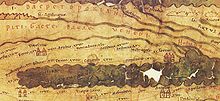
Summary
Troesmis was an ancient Dacian town and later ancient Roman city and legionary fortress, a major site situated on the Danube and forming a key part of the Limes Moesiae frontier system. It is situated in what is now Romania near Igliţa-Turcoaia. Around this fortress the Geto-Dacian town later developed.[1][2]
| Troesmis | |
|---|---|
 site | |
 Location within Romania | |
| Attested by | |
| Previous fortification | Getic |
| Place in the Roman world | |
| Province | Moesia Inferior |
| Directly connected to | Arrubium Ulmetum Carsium (Izvoarele) |
| Structure | |
| — Stone structure — | |
| Stationed military units | |
| — Legions — | |
| |
| Location | |
| Coordinates | 45°08′36″N 28°11′42″E / 45.1432°N 28.1951°E |
| Altitude | c. 38 m |
| Town | Turcoaia |
| County | Tulcea |
| Country | |
| Site notes | |
| Condition | Ruined |

Between 107 and 163 it was the home of the Roman Legio V Macedonica. The Notitia Dignitatum shows that during 337–361 it was the headquarters of Legio II Herculia.[3]
History edit
The ancient Dacian town of Troesmis was conquered by Lucius Pomponius Flaccus in about 15 AD, taken from the Getae and given to the Thracian king Rhescuporis II.[4]
After the conquest of Dacia in Trajan's Dacian Wars, he transferred the Legio V Macedonica from Oescus to Troesmis.[5] Two settlements grew up near the fortress, the canabae and the civil settlement called Troesmis. It became a municipium during Marcus Aurelius' reign.
In the second half of the 3rd century the town was destroyed during the Gothic invasions. The city and fortress were rebuilt and from 337 was garrisoned by the Legio II Herculia and the milites Secundi Constantini (Notitia Dig. or. 39.22.29. 31). It was also later rebuilt by Justinian I (r.527-565).[6] Excavations have found two walled cities, the eastern of 120 x 145 m with three basilicas from the time of Justinian and defended by exterior towers and by a vallum and a ditch. The western city, only 500 m from the other, is trapezoidal in plan.
It is included in the Itinerarium Antonini as between Beroe Piatra Frecăței and Arrubium and attests the presence of the Roman Legion Legio I Iovia, the Tabula Peutingeriana,[7] the Itinerarium Burdigalense, the Ravenna Cosmography, Hierocles and the Byzantine Emperor Constantine VII.[8]
Destruction of the site edit
The site was concessioned to Desire More by the Ottoman Empire for farming activities. In 1882 Desire More started excavations, and the stones from the ancient site were sold as construction materials in Galați and Brăila. Suspected by the local Muslim villagers that the scope of the excavation is a treasure hunt, a local revolt started. With the help of Engelhardt, the French representative in Danube Commission, armed intervention stopped the revolt. 24 epigraphic inscriptions were sent to France.[9] Four of the inscriptions were published by Theodore Mommsen in 1864.[10]
Research edit
From 1861 to 1867, the French government sent a team of archeologists led by Boissiere and Ernest Desjardins to Troesmis. The French team discovered 55 Latin inscriptions referring to the history of Troesmis, Legio V Macedonica and Legio I Italica.[11] The research was continued by Gr. G Tocilescu, who destroyed ancient site walls in order to find and save the inscriptions. [9]
References edit
- ^ "Gheorghe Mănucu-Adameșteanu, Comuna Turtucoaia, punct Iglița, cetățile Troesmis est și Troesmis vest. Considerații privind locuirea medio - bizantină din secolele X-XIII" (PDF).
- ^ "Turcoaia judetal Tulcea". Archived from the original on 2019-04-22.
- ^ TOCILESCU 1883a, p. 101
- ^ "P. Ovidius Naso, Ex Ponto, book 4, poem 9".
- ^ Ptol. Geog. 3.10.5
- ^ Procopius (De aed. 4.11.33)
- ^ Tabula Peutingeriana 8.3
- ^ Laura-Diana Cizer, Toponimia județului Tulcea: considerații sincronice și diacronice, 303 pag., Editura Lumen, 2012
- ^ a b Vasile Barbu, Cristian Schuster Grigore G. Tocilescu si "Cestiunea Adamclisi" Pagini din Istoria Arheologiei Romanesti ISBN 7-379-25580-0
- ^ Bulletin de l'Institut de Corespondance Archeologicque de Rome, December 1864
- ^ Gr. G Tocilescu Adresa catre "Domnule Ministru alu Resbelului", MNA Archive, D7, File 1888, folio 64


